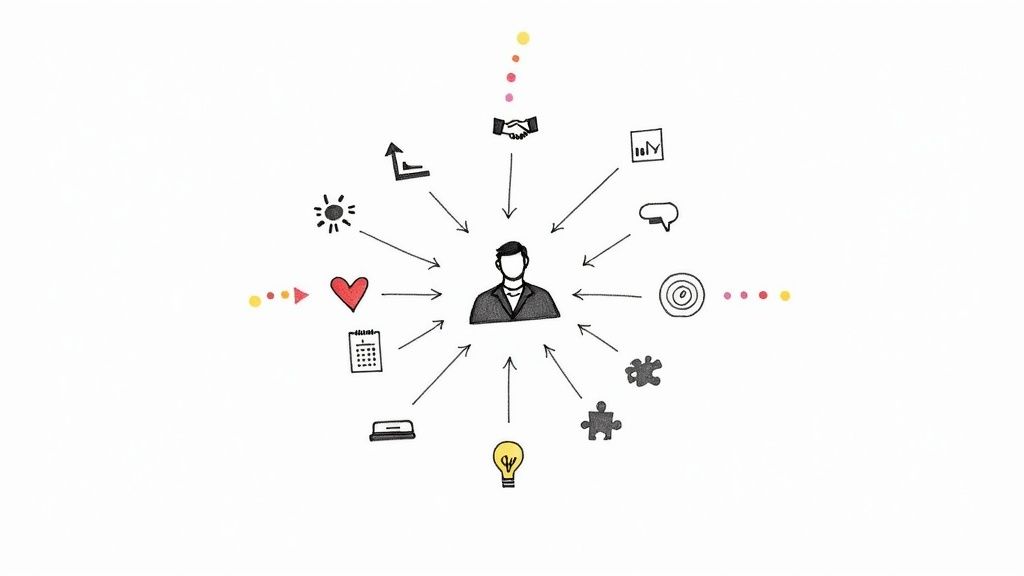Let's be honest, full life cycle recruitment isn't just another buzzword to toss around in meetings. It's the whole messy, complicated, and ultimately rewarding journey of hiring a human being. It starts with that first "we need someone" conversation and doesn't end until you have a happy, productive team member settled in six months down the line.
Turns out there’s more than one way to hire elite developers without mortgaging your office ping-pong table.
So, What Is Full Life Cycle Recruitment, Really?
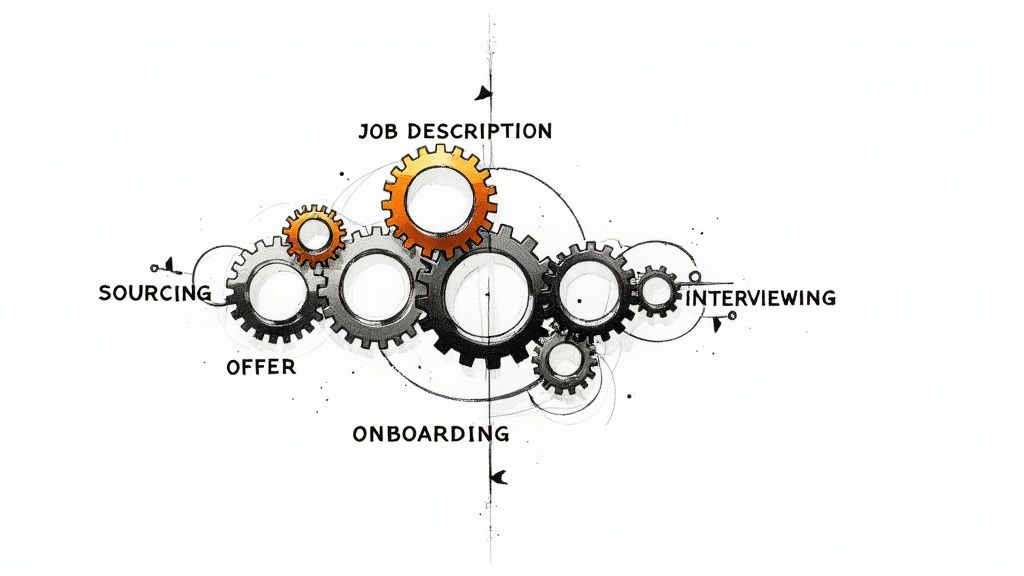
Most companies think they're doing it, but they're not. They're doing piecemeal hiring. They have one team for sourcing, another for interviewing, and a third for onboarding. They bolt on different tools and processes at each stage, creating a clunky, disjointed mess that candidates hate and founders can't stand.
Imagine trying to build a car by grabbing a wheel from a Toyota, an engine from a Ford, and seats from a junkyard. Sure, you have all the parts, but they were never designed to work together. That's exactly how the candidate experience feels—cobbled together and confusing. Your best prospects can feel it, and they'll run the other way.
The "Single Engine" Approach
True full life cycle recruitment is about owning the entire system from a single, unified perspective. It's about building one cohesive hiring engine, not just assembling a pile of mismatched parts. When one person or a tightly-knit team manages that whole journey, something powerful happens.
- You get real context. The person sourcing candidates knows exactly what the hiring manager needs because they helped write the job spec.
- Candidates feel valued. They have a single point of contact, not a confusing series of handoffs between three different people who clearly don't talk to each other.
- Feedback loops are instant. Insights from today's interviews immediately sharpen how you source tomorrow's candidates.
This isn’t just a nice-to-have; it’s a massive strategic advantage in a brutal hiring market. With the global recruiting market valued at a staggering USD 642.28 billion and projected to hit USD 924.29 billion by 2030, a disjointed process just won't cut it. The competition is too fierce.
We’re talking about a system where every stage informs the next. It creates a smarter, more efficient process that consistently lands A-players without driving you completely insane.
Why the Old Way Is Broken
The piecemeal approach fails because it creates silos. The sourcing team is judged on the volume of resumes, the interviewers on their technical grilling, and HR on how fast they can get paperwork signed. Nobody is accountable for the one thing that actually matters: finding the right person who sticks around and adds real value.
This guide is for founders and hiring managers who are tired of the chaos. We’re going to break down exactly why that fragmented approach is holding you back and show you how owning the full life cycle is the only way to build a team that actually wins. And if you're just starting out, a foundational guide on hiring your very first employee is a great place to get your bearings.
The Six Stages of The Hiring Gauntlet
Alright, let's get real. Forget the neat, tidy diagrams you see in HR textbooks. The actual full life cycle recruitment process is less of a "cycle" and more of a six-stage gauntlet. It's a series of trials where one wrong move can send your perfect candidate running for the hills—or worse, saddle you with a hire who looks great on paper but torpedoes your team's morale.
I’ve run this gauntlet more times than I can count, and trust me, each stage has its own unique way of making you want to tear your hair out. The secret isn't just knowing the steps; it's understanding where the landmines are buried.
This infographic breaks down the chaotic reality, showing just how many tools, handoffs, and drop-off points exist in a typical hiring process.
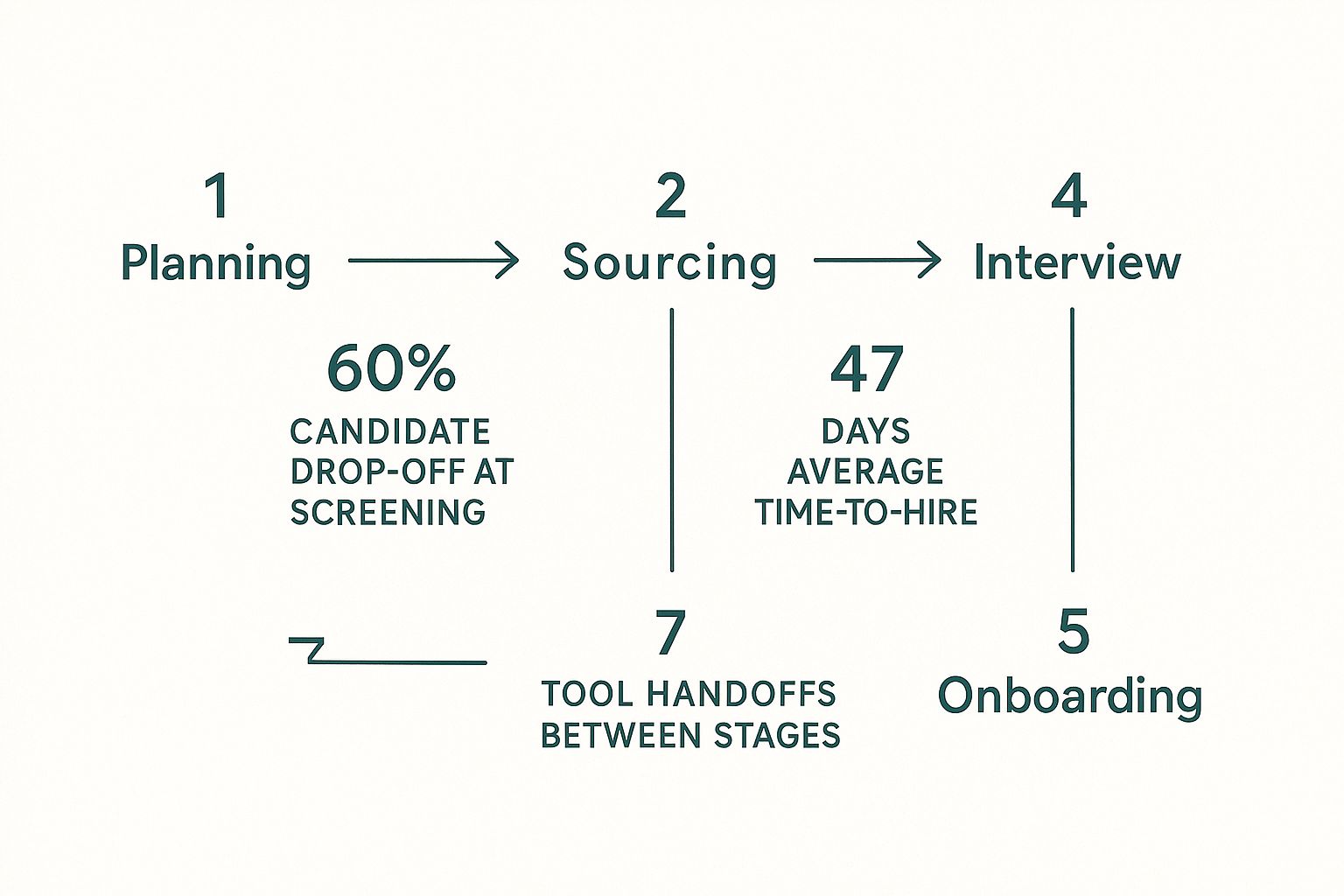
As you can see, the process is a leaky bucket, losing a huge chunk of candidates at the screening stage alone, all while taking an eternity to complete. Let's walk through the whole bloody affair.
For those of us who've been in the trenches, each stage of recruitment comes with its own classic headache. Here’s a quick, no-fluff breakdown of what you're up against and what you should be focused on instead.
Full Life Cycle Recruitment Stages From The Trenches
| Stage | Common Headache | The Real Goal |
|---|---|---|
| 1. Planning | "We just need a Senior Marketing Guru Ninja!" | Brutally defining the pain this person is being hired to solve. |
| 2. Sourcing | Posting on a job board and praying for a miracle. | Actively hunting for hidden gems who aren't looking. |
| 3. Screening | Drowning in a sea of buzzword-filled resumes. | Cutting through the noise without discarding your best prospects. |
| 4. Interviewing | A long parade of repetitive, trivia-based questions. | Testing for real-world problem-solving, not just textbook knowledge. |
| 5. Offer | A lowball number and a generic "welcome aboard" email. | Selling a mission and making the candidate feel valued. |
| 6. Onboarding | Throwing a new hire into the deep end with no life raft. | Proving they made the right choice by setting them up for a Day 90 win. |
Each of these stages is a potential failure point. Let's break down how to navigate them without losing your mind (or your top candidates).
Stage 1: The 'Are We Sure We Need This Role?' Planning Phase
This is where most hiring disasters begin. It starts with a vague feeling of being overwhelmed, which quickly turns into a conviction: "We need to hire someone!" Stop right there.
Before you write a single word of a job description, you need to brutally define the pain. What specific problem is this person being hired to solve? If you can't articulate it in a single sentence, you're not ready to hire.
The goal of this stage isn't to write a job description. It's to build a scorecard for success. What does this person need to accomplish in their first 90 days to be considered a win?
Get this wrong, and you'll spend two months interviewing people for a job you haven't even properly defined. It's the most common, and most expensive, unforced error a founder can make.
Stage 2: The Great Candidate Hunt (Sourcing)
So you have your mission-critical problem defined. Now you have to find the hero who can solve it. Sourcing isn’t just about posting on a job board and hoping for the best. That’s like fishing with a single piece of bait in the middle of the ocean and expecting a bluefin tuna to jump into your boat.
Effective sourcing is an active hunt. It involves:
- Tapping your network: Not just asking "who do you know?" but "who is the smartest person you know who solves this specific type of problem?"
- Searching where others don't: Looking in niche communities, open-source project contributions, or industry forums.
- Building a bench: Identifying great people before you have a role for them.
This stage is a grind. You'll send dozens of outreach messages that get ignored. But finding one hidden gem who isn't actively looking makes it all worthwhile.
Stage 3: The Resume Black Hole (Screening)
Here comes the flood. Your inbox is overflowing with PDFs, and they all start to look the same. "Synergized," "results-driven," "passionate." It's a sea of buzzwords. The temptation is to scan for keywords and toss the rest.
Don't. The best candidates often have the weirdest resumes because they've been busy doing interesting work, not optimizing their CVs. This is where you need a system to cut through the noise without discarding your best prospects. It's also where having a rock-solid process matters most, and using a detailed hiring process checklist can keep you from losing your mind.
Stage 4: The 'Please Have a Personality' Interview Gauntlet
You've narrowed it down to a handful of promising people. Now comes the parade of interviews. The phone screen, the technical deep-dive, the "culture fit" chat, the team panel… it's exhausting for everyone involved.
The biggest mistake here is testing for trivia instead of talent. Asking a developer to write a sorting algorithm on a whiteboard doesn't tell you if they can solve your customer's actual problem. Instead, structure your interviews around real-world challenges your company is facing.
Stage 5: The Awkward Offer Dance
You found them. The one. They nailed the interviews and the team loves them. Now you have to make an offer without screwing it up.
This is more than just a number. It's a negotiation that signals how much you value them. Be prepared, be fair, and be transparent. Explain the entire compensation package—salary, equity, benefits—and sell the vision. The goal is to make them feel like they're joining a mission, not just clocking in for a paycheck.
Stage 6: The 'Don't Screw This Up' Onboarding
They accepted! Pop the champagne, right? Not so fast. The full life cycle recruitment process isn't over until your new hire is a fully integrated, productive member of the team. The first 90 days are critical.
A bad onboarding experience—no clear first project, no introductions, no one to have lunch with—is the fastest way to turn an enthusiastic new hire into a flight risk. Onboarding is your final responsibility in the cycle. It’s your chance to prove they made the right choice.
Mastering Planning and Sourcing
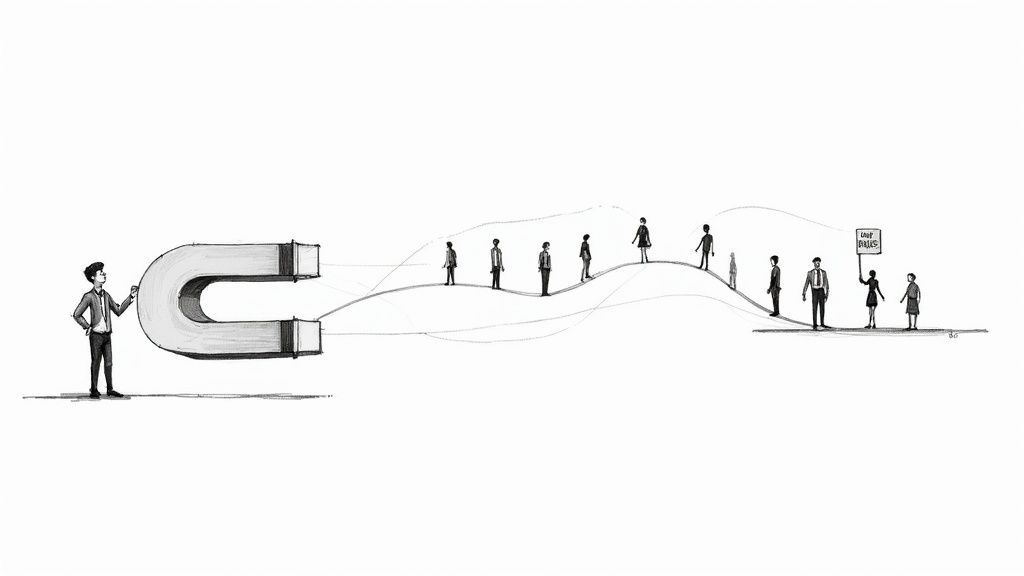
Let's get one thing straight: this is where at least 90% of hiring mistakes are born. Get these first two steps wrong, and the rest of your full life cycle recruitment process is just a costly, time-sucking exercise in futility. You'll end up interviewing dozens of perfectly nice people who are completely wrong for the job.
It all starts with a vague, panicked thought—"We need a marketer!"—and snowballs into a generic job description pulled from the internet. You’re not hiring a job title; you’re hiring someone to solve a painful, specific business problem. If you can't define that problem, you're just throwing money into the wind.
Stop Writing Job Descriptions, Start Building Scorecards
Forget the bulleted list of "responsibilities." It’s corporate fluff that attracts people who are good at sounding busy. Instead, create a "Mission & Outcomes Scorecard." This is a simple document that answers the only questions that matter.
- What is the mission? Define the core problem in one sentence. Example: "Build a predictable lead-generation engine that delivers 50 qualified sales calls per month."
- What are the key outcomes? List 3-5 measurable results this person must achieve in their first six months. Example: "Reduce customer acquisition cost by 15% by the end of Q2."
This isn't just about clarity; it's a powerful filter. A-players are drawn to clear missions and measurable impact. Tire-kickers are scared off by them. You've just pre-screened your entire applicant pool without reading a single resume.
Sourcing Is Hunting, Not Fishing
Now that you have your scorecard, you can finally start looking for the right person. Posting on LinkedIn and praying is not a strategy. That’s fishing. You’re passively waiting for something to bite, and you'll mostly catch whatever happens to be swimming by.
Real sourcing is an active hunt. It's about identifying the exact people who can achieve the outcomes on your scorecard and then going after them. The best candidates are almost never looking for a job—you have to convince them to take yours.
The goal of sourcing isn't to get a high volume of applicants. It's to get a handful of perfectly qualified people into your pipeline, even if they don't know they're in the market for a new role yet.
This means you have to get creative. Start by mapping out where these people congregate. Is it a specific GitHub repository? A niche Slack community? A small industry conference your competitors ignore? Go there.
In this stage, your outreach is everything. The ability to craft initial outreach emails that get replies can significantly boost your candidate pipeline. Your message needs to be personalized, concise, and focused on the mission, not the job title.
For more on this, we've got a whole playbook on proven candidate sourcing strategies that go way beyond just keyword searches. It’s about building a real talent pipeline before you're desperate to fill a role.
The takeaway is simple: a brilliant sourcing strategy for the wrong profile is a complete waste of time. Master the planning phase first by defining the problem, then unleash a targeted hunt for the person who was born to solve it. Get that foundation right, and the rest of the hiring gauntlet becomes infinitely easier.
Winning at Screening and Interviewing
Hope you enjoy spending your afternoons fact-checking resumes and running technical interviews—because that’s now your full-time job. Kidding. Sort of. Welcome to the stages of full life cycle recruitment that devour the most time and energy.
If planning and sourcing are about building the right pipeline, screening and interviewing are about making sure you don't let a great candidate slip through—or a terrible one suck up weeks of your time.
The old way is broken. You post a job, get a flood of 200 resumes, and then your brain turns to mush trying to keyword-scan them all. “Proficient in Microsoft Word.” Great. “Team player.” Fantastic. This isn't screening; it's a lottery where you hope to accidentally find someone decent.
This manual approach is a time sink. Recruiters spend, on average, just seven seconds looking at a resume. In that frantic glance, you’re more likely to spot a typo than true potential. We need a smarter filter.
Beyond the Buzzword Bingo
Let's kill the idea that screening is about matching keywords on a resume to keywords in a job description. That’s how you hire people who are great at writing resumes, not people who are great at their jobs. True screening is about identifying signals of competence and drive.
Instead of just scanning, look for evidence:
- Side projects or portfolios: What have they built or created in their own time? This shows passion and initiative, things that never show up in a bullet point.
- Thoughtful cover letters: Did they write a generic template, or did they actually read your job description and connect their experience to your specific problems?
- Career trajectory: Are they consistently taking on more responsibility? A pattern of growth is a far better indicator than a list of skills.
This is still a grind, but it focuses your energy on substance, not superficial polish. You're looking for the doers, not just the talkers.
The Interview Is Not a Quiz Show
Alright, you've shortlisted a handful of candidates who look promising. Now for the interview gauntlet. The biggest mistake founders and managers make here is turning the interview into a pop quiz.
"How many golf balls fit in a 747?" Who cares? Unless you’re hiring a professional golf ball packer for Boeing, the question is useless.
The interview's sole purpose is to answer one question: can this person solve the specific problems I am hiring them to solve?
Stop testing for trivia and start testing for talent. A great interview feels less like an interrogation and more like a collaborative problem-solving session.
Give them a real, slightly simplified problem your team has faced. Watch how they think. Do they ask clarifying questions? Do they break the problem down into smaller pieces? Do they get flustered or do they get curious? The process they use to find the answer is far more revealing than the answer itself. To dive deeper into this, we have some solid advice on how to conduct effective interviews that get past the rehearsed answers.
Scaling Yourself with Asynchronous Interviews
The problem with this thoughtful, problem-based approach? It takes a ton of time. Doing this for every single shortlisted candidate is a recipe for burnout. Your calendar becomes a solid wall of 30-minute introductory calls that mostly go nowhere.
This is where you bring in the robots. Kidding again. But seriously, this is where you use technology to get your time back. Asynchronous video interviews are a game-changer for the initial screening phase.
Instead of a phone call, you send your top 10-15 candidates a link with 3-4 pointed questions. They record their answers on their own time, and you review them on yours.
This isn’t about replacing human connection; it’s about saving that high-value connection for the candidates who truly deserve it. You can screen an entire shortlist in the time it would take to do two live phone screens. You immediately get a sense of their communication style, their energy, and how they articulate their thoughts—all without a single scheduling headache.
By redesigning your screening and interviewing process, you shift your effort from high-volume, low-value interactions to low-volume, high-impact conversations. You spend less time talking to bad fits and more quality time convincing your future A-player that your company is the right place for them.
Closing The Deal with Offers and Onboarding
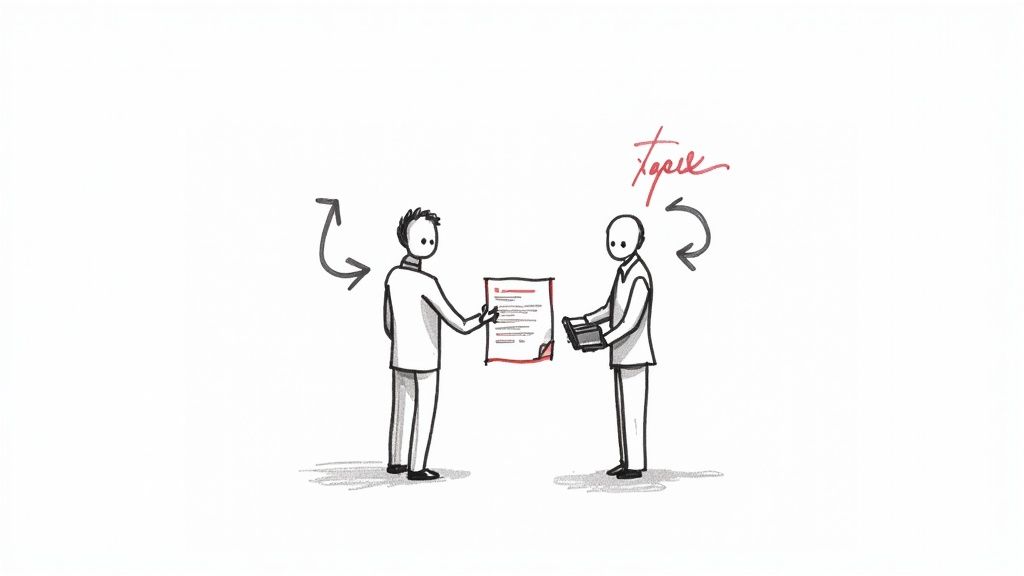
You did it. You’ve made it through the gauntlet of planning, sourcing, screening, and interviewing. You’ve found the one. Now, whatever you do, don't drop the ball at the finish line. This is the moment where full life cycle recruitment shifts from evaluation to persuasion.
Sending a lowball offer in a generic, two-sentence email is the recruiting equivalent of getting down on one knee and mumbling, “So, wanna get hitched?” It’s flat, uninspired, and basically dares your top candidate to see what your competitors are offering.
The offer stage is more than just a salary figure; it's a delicate dance that sets the entire tone for your future relationship. Your candidate has options—the best ones always do. It's your job to make them feel like joining your team is the only move that makes sense.
The Art of the Irresistible Offer
First things first: pick up the phone. An email can't convey excitement, but a human voice can. Personally walk them through the offer, explaining not just the salary but the whole package: equity, benefits, growth potential, and—most importantly—the mission they are about to join.
An offer should feel less like a transaction and more like the beginning of a partnership. Be ready for their questions, be transparent about how you landed on the numbers, and be prepared to negotiate in good faith. A little flexibility now can save you a world of hurt later when you’re back at square one, staring down another mountain of resumes.
The goal of the offer isn't just to get a 'yes.' It's to get an enthusiastic 'hell yes!' You want them so excited that they're already picturing their first day before you even hang up the phone.
Once they accept, it's time to celebrate! But don't get too comfortable. The ink isn't truly dry on that contract until they are a happy, contributing member of the team. The real work is just getting started.
Onboarding Is Not an Admin Task
Congratulations, they said yes! The clock has now started on the single most critical period of their employment: the first 90 days. This is your chance to either validate their decision or fill them with a serious case of buyer's remorse.
Real onboarding isn't just a welcome packet and a new laptop. That's just checking administrative boxes. A truly great onboarding program is a strategic process designed to integrate a new person into your company's culture and workflow as seamlessly as possible. Botch this, and you'll see why poor onboarding is a leading cause of early turnover; new hires are 58% more likely to still be with a company after three years if they went through a structured onboarding process.
The objective is simple: get them to a place of productivity and belonging fast. They need to know what’s expected, who to turn to for help, and how their role fits into the bigger picture.
Your First 30 Days Blueprint
Don't just toss them into the deep end and hope they figure out how to swim. Hand them a life raft and a map. A structured plan for their first month is absolutely non-negotiable.
- Week 1: The Welcome Tour: Schedule one-on-ones with key team members—not just their direct reports, but people in other departments they’ll collaborate with. Get their tools set up, invite them to all the right Slack channels, and assign them a buddy who isn't their manager.
- Week 2: The First Small Win: Give them a well-defined, low-stakes project they can own from start to finish. This builds immediate confidence and helps them learn the ropes without the crushing pressure of a mission-critical task.
- Weeks 3-4: Deep Dive & Feedback: By now, they should be getting their hands dirty with more substantial work. Schedule a 30-day check-in to give and receive honest feedback. What’s going well? What’s still confusing? What do they need from you to succeed?
This structured approach demonstrates you're invested in their success, not just in filling an empty seat. It’s the final, crucial step in the full life cycle recruitment journey—one that turns a promising new hire into a high-impact, long-term teammate. Get this part right, and you'll secure your hiring ROI. Get it wrong, and you'll find yourself running that same gauntlet all over again.
Common Full Life Cycle Recruitment Questions
Alright, we’ve covered a lot of ground. Your head is probably buzzing with questions. That’s a good sign—it means you’re taking this seriously. Let’s tackle some of the most common ones I hear from other founders trying to wrestle their hiring process into submission.
This is the quick-fire round. No fluff, just direct answers based on years of doing this the hard way, so you don’t have to.
How Long Does Full Life Cycle Recruitment Typically Take?
There’s no magic number, and anyone who gives you one is selling something. For a senior technical role in a competitive market, a well-run process can easily take 45-60 days from the initial planning session to the signed offer letter. For other roles, it might be quicker.
But here’s the thing: the goal isn’t just speed. You can hire fast and still get it horribly wrong. The real objective is to make a high-quality hire efficiently, without burning out your team or leaving great candidates hanging in the dark for weeks. A rushed process often leads to a bad hire, which will cost you far more time and money in the long run than a few extra weeks of diligence.
Your time-to-hire metric is useless if your nine-month retention rate is in the gutter. Focus on a repeatable, high-quality process, and the right timeline will follow.
What's The Biggest Mistake Founders Make in This Process?
Easy. Skipping the planning phase. I’ve seen it a thousand times. A founder feels the pressure, panics, and jumps straight to writing a job description and spamming LinkedIn. It’s a classic, costly mistake.
They haven’t taken the time to define the core problem the new hire needs to solve. What pain point is so acute that you're willing to spend six figures to make it go away? If you can’t answer that with brutal clarity, you're not ready to hire. This leads to a vague search, attracting the wrong kind of candidates and wasting countless hours on interviews that go absolutely nowhere.
Everything else—sourcing, interviewing, closing—depends on a rock-solid foundation built during planning. Don't build your house on sand.
Can A Small Startup Really Handle The Full Cycle In-House?
Absolutely. In fact, I’d argue it’s better for early-stage startups to own the entire process. No external recruiter will ever understand your mission, your culture, or your specific needs as well as you do.
Let's be real, it requires a significant time investment from the founder or a key team member. There will be days you feel more like a recruiter than a CEO. But the payoff is immense. Building your core team with people who are true believers, vetted by you personally, is one of the highest-leverage things you can do.
The key is to not go it alone. Use smart tools to automate the repetitive parts (like initial screening) and create a clear, repeatable process you can stick to. It's not about doing more work; it's about doing the right work.
When Should I Consider Outsourcing Recruitment?
Outsourcing isn't a silver bullet, but it has its place. You should start thinking about bringing in an external partner in two specific scenarios:
- When you need to scale fast: If you just closed a funding round and need to hire ten engineers yesterday, you simply won't have the internal bandwidth. A good agency can provide the surge capacity you need.
- When you’re hiring for niche roles: Need a quantum computing specialist or a lead metallurgist? If the role is far outside your team’s network and expertise, a specialized recruiter can be worth their weight in gold.
But even when you outsource, you can't abdicate responsibility. The founder or hiring manager must stay deeply involved in the final interview and offer stages. You're still the ultimate gatekeeper of quality and culture fit. Don't ever let an outside firm make the final call for you.
Ready to stop drowning in resumes and start spending your time with top candidates? Async Interview gives you the tools to automate your initial screening, identify the best talent faster, and reclaim your calendar. See how it works by visiting https://asyncinterview.io and start your free trial today.

